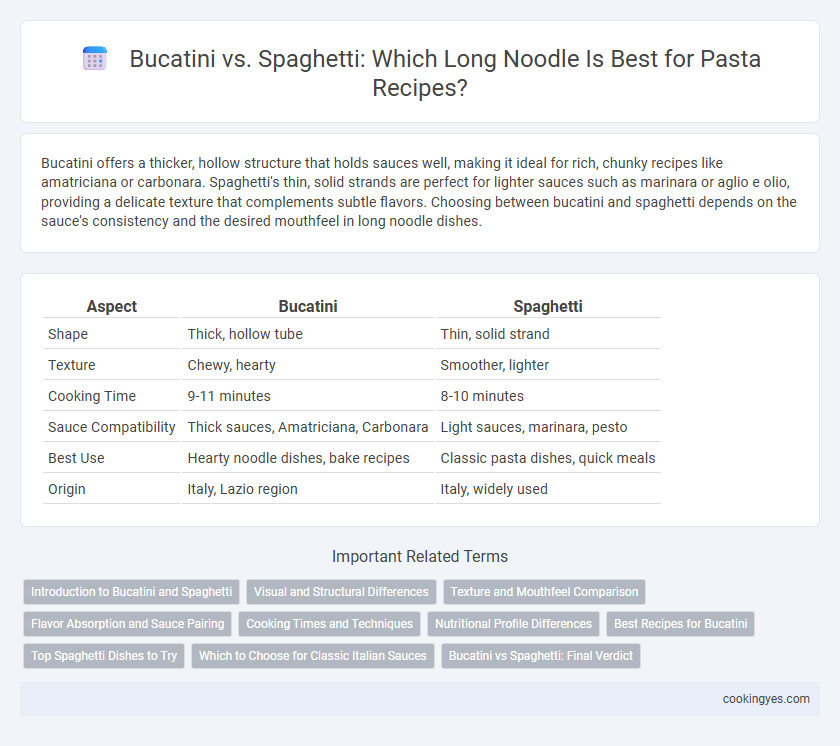Bucatini offers a thicker, hollow structure that holds sauces well, making it ideal for rich, chunky recipes like amatriciana or carbonara. Spaghetti's thin, solid strands are perfect for lighter sauces such as marinara or aglio e olio, providing a delicate texture that complements subtle flavors. Choosing between bucatini and spaghetti depends on the sauce's consistency and the desired mouthfeel in long noodle dishes.
Table of Comparison
| Aspect | Bucatini | Spaghetti |
|---|---|---|
| Shape | Thick, hollow tube | Thin, solid strand |
| Texture | Chewy, hearty | Smoother, lighter |
| Cooking Time | 9-11 minutes | 8-10 minutes |
| Sauce Compatibility | Thick sauces, Amatriciana, Carbonara | Light sauces, marinara, pesto |
| Best Use | Hearty noodle dishes, bake recipes | Classic pasta dishes, quick meals |
| Origin | Italy, Lazio region | Italy, widely used |
Introduction to Bucatini and Spaghetti
Bucatini and spaghetti are two popular types of Italian pasta commonly used in long noodle recipes. Bucatini is a thick, hollow pasta that holds sauce inside its tube, making it ideal for rich, hearty sauces like Amatriciana. Spaghetti, on the other hand, is a thin, solid noodle prized for its versatility and ability to pair well with a wide range of sauces, from simple tomato to creamy carbonara.
Visual and Structural Differences
Bucatini features a hollow center, offering a unique texture and allowing sauces to cling inside and out, while spaghetti is solid and smooth, providing a classic, uniform bite. The thickness of bucatini is slightly greater than spaghetti, giving it more visual presence and a chewier mouthfeel. These structural differences influence cooking times and sauce pairing, with bucatini better suited for thicker, hearty sauces and spaghetti ideal for lighter, oil-based dressings.
Texture and Mouthfeel Comparison
Bucatini offers a chewier texture and hollow center that delivers a unique, satisfying mouthfeel compared to the denser, smoother bite of spaghetti. The thicker diameter of bucatini allows it to hold heavier sauces and provides a more substantial chewing experience. Spaghetti's uniform surface creates a classic silky texture, making it ideal for lighter sauces where a delicate pasta presence is preferred.
Flavor Absorption and Sauce Pairing
Bucatini's hollow center enhances flavor absorption by allowing sauces to fill the noodle, making it ideal for rich, chunky sauces such as amatriciana or carbonara. Spaghetti's solid, slender shape pairs well with lighter, smoother sauces like marinara or aglio e olio, providing a balanced coating without overwhelming the noodle. For recipes emphasizing intense sauce integration, bucatini offers a more immersive taste experience compared to spaghetti.
Cooking Times and Techniques
Bucatini requires slightly longer cooking times than spaghetti, typically around 9-12 minutes to achieve an al dente texture due to its thicker diameter and hollow center. Spaghetti cooks faster, usually in 7-9 minutes, making it ideal for quick meals but less suited for sauces that benefit from the hollow structure of bucatini. Techniques for bucatini often involve stirring more gently to prevent breakage, while spaghetti demands consistent boiling and frequent stirring to avoid clumping.
Nutritional Profile Differences
Bucatini contains slightly more calories and carbohydrates per serving than spaghetti due to its thicker hollow structure, providing increased energy for long noodle recipes. Both pastas offer similar protein content, but bucatini's higher fiber content aids in digestion and sustained fullness. Spaghetti, being thinner, typically cooks faster and has a lower glycemic index, making it a favorable option for blood sugar management.
Best Recipes for Bucatini
Bucatini, thicker and hollow, holds rich sauces better than thin spaghetti, making it ideal for hearty recipes like Amatriciana and carbonara. Its robust texture complements chunky tomato-based sauces, enhancing flavor absorption. Bucatini's unique structure transforms traditional long noodle dishes, offering a satisfying bite and elevated taste experience.
Top Spaghetti Dishes to Try
Bucatini and spaghetti are classic long noodle options, each offering unique textures for top spaghetti dishes to try. Bucatini, with its hollow center, adds extra bite and holds rich sauces like amatriciana or carbonara exceptionally well, enhancing flavor absorption. Spaghetti's smooth, slender strands are perfect for traditional recipes like spaghetti aglio e olio or classic spaghetti bolognese, delivering a lighter, more delicate pasta experience.
Which to Choose for Classic Italian Sauces
Bucatini and spaghetti both excel with classic Italian sauces, but bucatini's hollow center holds thicker, hearty sauces like amatriciana and carbonara better, enhancing flavor absorption. Spaghetti's thinner, solid strands pair perfectly with lighter, smoother sauces such as aglio e olio or pomodoro, allowing for even coating without overpowering the pasta's texture. Choosing between bucatini and spaghetti depends on sauce consistency and desired mouthfeel to create an authentic Italian dining experience.
Bucatini vs Spaghetti: Final Verdict
Bucatini offers a thicker, hollow texture that absorbs sauces more effectively, making it ideal for rich, chunky recipes like Amatriciana or carbonara. Spaghetti's thinner, solid structure provides a smoother mouthfeel and is better suited for lighter, oil-based or tomato sauces. Choosing between Bucatini and spaghetti depends on the sauce's consistency and the desired texture in long noodle dishes, with Bucatini enhancing hearty flavors and spaghetti complementing delicate ones.
Bucatini vs spaghetti for long noodle recipes Infographic

 cookingyes.com
cookingyes.com